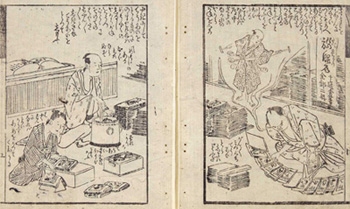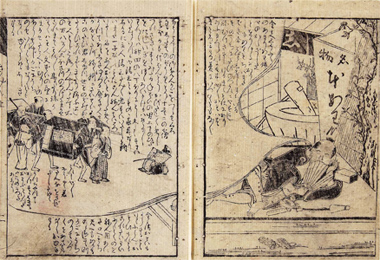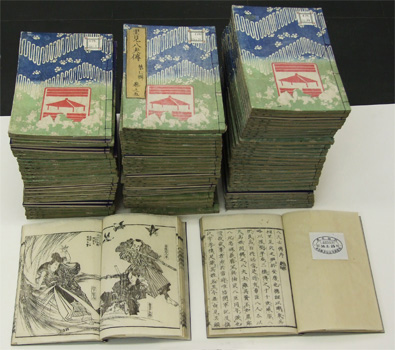Great-Edo Culture
Edo learning / Jihon and EzōshiBookshops of Edo
from "Picture Book: Amusements of Edo"
(Ehon Azuma Asobi Ezoshi-dana)
Compiled by Asakusa-an, Painted by Katsushika Hokusai 1802 (Kyōwa 2)
The 18th century saw the focus of culture shift gradually from the kamigata region (Kyoto and Osaka) gradual to Edo. Jihon refers to books produced locally in Edo, in comparison with kudaribon that were publish and transported to Edo. As such, jihonya that sold jihon played a significant role in the development of the city's publication culture.
Tsutaya Jūzaburō (1750 - 1797) was one of the most well-known heads of a jihondonya. He was involved in the publication of many book-genres and picture prints. These included Yoshiwara saiken (guidebooks of the licensed quarter), ehon (picture books), nishiki-e (colored wood-block prints), keiko-bon (collections of Japanese songs), and ōraimono (textbooks for children). He also enjoyed friendships with many persons of culture and high-education, whom he helped with the publication of their works.
Painted by Koikawa Harumachi 1775 (Anei 4)
A new type of literature called gesaku (dramatic work) emerged in Edo at the end of the 18th century. Gesaku represented a clear departure from ukiyo zōshi (books of the floating world) that had previously been developed in the kamigata region of Kyoto and Osaka. Many genres of literature appeared in response to the demands of readers. For example, residents gave the name, kibyōshi, to picture books targeted at an adult readership. Many formats emerged, including sharebon (books offering entertaining advice), kokkeibon (joke books), yomihon (fiction), and ninjōbon (erotica). Tsutaya Jūzaburō was one of the most famous publishers of this period.
Painted by Kyokutei Bakin
1814 - 1842 (Bunka 11 jo - Tempō 13)
It was the circulating library that connected the work and the reader. As printed matter was expensive, the circulating library was also popular. It is reported that there existed some 656 circulating libraries in 1806 (Bunka 5), catering to over 100,000 people. Not only bookshops but circulating libraries also played an important role in the development of a publishing culture, all supporting one another.
* To view more explanation, please click the each image.





